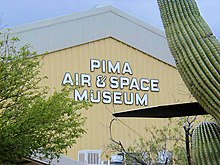Pima Air & Space Museum
 |
|
| Established | 1976 |
|---|---|
| Location | 6000 East Valencia Road, Tucson, Arizona, United States |
| Coordinates | 32°8′25″N 110°52′0″W / 32.14028°N 110.86667°W |
| Type | Private: aerospace |
| Director | Scott Marchand |
| Website | PimaAir.org |
The Pima Air & Space Museum, located in Tucson, Arizona, is one of the world's largest non-government funded aerospace museums. The museum features a display of nearly 300 aircraft spread out over 80 acres (320,000 m²) on a campus occupying 127 acres (610,000 m²). It is also, since 1991, home to the Arizona Aviation Hall of Fame.
Opened to the public in May 1976 with 48 aircraft then on display, the Museum's main hangar houses an SR-71A Blackbird, an A-10 Warthog, a United States Air Force Through the Years exhibit, and a mock-up of a control tower.
The museum is adjacent to Davis-Monthan Air Force Base. The 309th Aerospace Maintenance and Regeneration Group (AMARG), affiliated with the base, also known as the "Graveyard of Planes" or "The Boneyard", is the largest aircraft storage and preservation facilities in the world. Bus tours of the boneyard leave from the museum several times a day from Monday to Friday, except Federal holidays.
The nearby Titan Missile Museum is located about 20 miles south of Tucson in Green Valley off of Interstate 19 and features a Titan II intercontinental ballistic missile still in its silo. Tours of the above-ground and underground installations around the missile are conducted daily. More extensive "top to bottom" tours take up to five hours and are conducted several times each month. Reservations required for top to bottom tour.
Both museums are overseen by the Arizona Aerospace Foundation and are governed by the Board of Trustees. They are non-profit 501 (c) 3 organization that relies on visitors paying admissions, for trams and AMARG tours, as well as what they spend in the Museum stores. They also rely on memberships and contracted events to pay to restore and acquire exhibits.
...
Wikipedia
